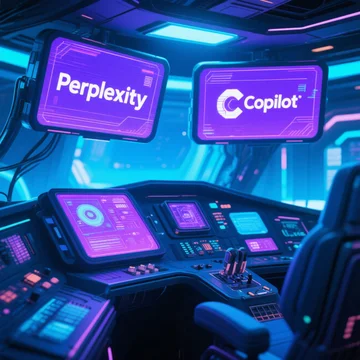Choosing the right AI assistant can significantly boost productivity and code quality. In this guide, we break down Perplexity vs Copilot to help developers decide which tool delivers more value in real-world workflows—from research to code generation.

Why Compare Perplexity vs Copilot?
As AI tools become essential for developers and tech teams, understanding how Perplexity vs Copilot stack up is crucial. Perplexity AI, known for its research-focused generative capabilities, and GitHub Copilot, praised for real-time coding assistance, offer different advantages. While both are AI-powered, their core functions, integrations, and value propositions differ greatly. This blog explores how each tool fits into developer workflows and which might be the better choice depending on your needs.
Perplexity AI: A research-oriented AI assistant designed to generate concise, source-backed answers to technical and non-technical questions.
GitHub Copilot: A code-completion tool built on OpenAI Codex, integrated into IDEs like VS Code, JetBrains, and Neovim for real-time suggestions.
Interface and Ease of Use: Perplexity or Copilot?
Perplexity AI offers a clean chat-style interface, ideal for research-heavy tasks. Its Pro mode provides access to various focus modes like "Academic," "Writing," and "Programming." It’s intuitive and requires no IDE setup.
In contrast, Copilot is embedded directly into your development environment. Once installed, it runs passively and suggests lines of code based on the context. This seamless integration makes it highly efficient during live coding sessions.
? Perplexity AI
No setup needed, works in browser, great for gathering knowledge before writing code or reports.
? GitHub Copilot
IDE-native experience, perfect for real-time code writing, auto-suggestions, and debugging.
Features Breakdown: Perplexity vs Copilot
Let’s dive into the core features that define the experience of using Perplexity AI and GitHub Copilot. While they serve different purposes, many developers find combining both creates a powerful productivity stack.
Key Features of Perplexity AI:
? Real-time web and academic search with cited sources
? Custom focus modes for programming, writing, and research
? AI model flexibility (GPT-4o, Claude, Mistral)
? Conversational thread memory
Key Features of GitHub Copilot:
? Autocompletion for code in real-time
? Supports 20+ programming languages
? Built into VS Code, JetBrains, and other IDEs
? Comment-based code generation
Pricing Comparison
Budget plays a key role when deciding between Perplexity vs Copilot. Here's a breakdown of current pricing models:
Perplexity Pro: $20/month with access to GPT-4o, focus modes, and citations.
GitHub Copilot: $10/month for individuals, $19/month per seat for business plans.
While Copilot is slightly cheaper, Perplexity offers broader AI capabilities outside of just code, making it more versatile for full-stack developers, tech writers, and research-heavy roles.
Use Cases: When to Use Each Tool
Still debating Perplexity vs Copilot? Consider these real-world scenarios where one tool outshines the other:
?? When to Use Perplexity AI:
? Researching algorithms and libraries
? Generating technical blog content
? Debugging with documentation and citations
?? When to Use Copilot:
? Writing boilerplate code faster
? Pair programming for speed
? Real-time test generation or debugging
Accuracy and Trustworthiness
Perplexity AI cites sources from the web, making it an excellent option for verified insights and technical research. GitHub Copilot, however, doesn’t cite sources, and occasionally generates incorrect or insecure code, so human oversight is crucial.
Developers working on production systems may prefer Perplexity when confirming logic, syntax, or configuration instructions. For local prototyping, Copilot excels with its rapid suggestions.
Integration and Compatibility
Copilot’s biggest advantage lies in its native integration with GitHub and Visual Studio Code. It complements workflows by suggesting code snippets right inside your editor.
Perplexity doesn’t integrate with IDEs but excels as a browser-based assistant that supports context-aware research. It complements documentation review, API exploration, and general learning tasks.
Developer Feedback and Community Adoption
Among developers, the debate on Perplexity vs Copilot often comes down to workflow preferences. Stack Overflow reports growing interest in Perplexity for research and architecture planning, while GitHub Copilot is increasingly used for rapid coding tasks.
"Copilot helps me code faster, but Perplexity helps me think deeper,"
— Software Engineer, Reddit r/learnprogramming
@devResearcher: "Copilot writes my functions. Perplexity helps me understand why they exist."
Final Verdict: Which AI Assistant Should You Choose?
When it comes to Perplexity vs Copilot, there’s no universal winner—each has unique strengths. If you’re a developer looking for seamless code completion, GitHub Copilot will likely serve you better. If your workflow demands research, accuracy, and a broader understanding of topics before implementation, Perplexity AI is a more well-rounded tool.
Power users may benefit from using both tools together—Perplexity for exploration and validation, Copilot for execution. Their synergy can significantly streamline the entire software development lifecycle.
Key Takeaways
? Use Perplexity AI for research, documentation, and learning
? Use GitHub Copilot for real-time code generation
? Combining both tools can optimize your full development workflow
? Perplexity offers source citations; Copilot offers speed
? Choose based on whether your priority is knowledge or code output
Learn more about Perplexity AI
